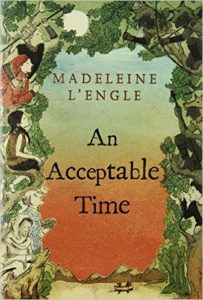An Acceptable Time strikes me as unusually autumnal for a young adult novel. Meg, the heroine of A Wrinkle in Time, has moved off-stage in this, the fifth novel of the Time quintet. Her daughter Polly shares the spotlight with her parents (Polly’s grandparents), Alex and Kate Murray, doctors of physics and chemistry, respectively. The story begins in a New England autumn, and Polly is the only young person around. When Zachary, another character her age shows up, he turns out to be gravely ill, possibly closer to the end of his life than any of the elderly characters with whom he shares the page.
Polly, like Meg, enjoys the outdoors, and spends a great deal of her time — she has left high school for further, pre-university, instruction from her scientific grandparents — exploring the woods surrounding the family home. L’Engle sketches the environs vividly, and the return to a setting from the quintet’s beginning adds to the autumnal feel of the tale. Everything is old, nearing its end. Or perhaps, from a different point of view, about to enter a quiet period of renewal.
This wouldn’t be a L’Engle Time book if tempus weren’t some sort of a fugitive in its pages, and so it is that Polly first sees some unknown people near the house and soon after slips several thousand years into the area’s distant past. Most of the rest of the story turns on her figuring out what is going on in that time, what the connections might be between then and Polly’s present (the book was published in 1989) and whether there is a purpose to Polly’s ability to navigate among two circles of time.
Because of course the region is inhabited in the time that Polly slips into: two tribes are close to war over food and water. One occupies fertile lands, watered from snow runoff arising from the Ice Age’s retreating glaciers, and usually blessed with regular rainfall. The other tribe lives across the lake in land that is less fertile. Rain for both has been scarce lately, and the people across the lake have stepped up their raids for food. Some in both tribes say that a sacrifice will appease the divine forces that send or withhold rain. In that volatile atmosphere, Polly appears, joined a short time later by Zachary.
The circles of time move closer together, and more people make their way across the millennia; are divine forces at work in shifting time as well? One of Polly’s grandparents’ friends is a retired Episcopalian bishop; he, too, has occasionally moved into the time of the lake peoples. As the story plays out, L’Engle raises questions of sacrifice and belief, of science and religion, and of history and legend.
It’s very interesting, this book for young adults that was written by a woman in her seventieth year of life. There’s a certain amount of teen angst, and of romance. L’Engle was too keen an observer of the human condition for too long to have left out such salient characteristics of teenagers. But she places her young people amidst older folks who are not just relics, but lively people in their own right, by no means finished with growing and learning. Polly is the central character, but the world would go on without her. The drama of teenagerdom feels reduced, autumnal. It’s a good story, well told, that runs against its genre’s tendency to heighten events; an acceptable contrast.

